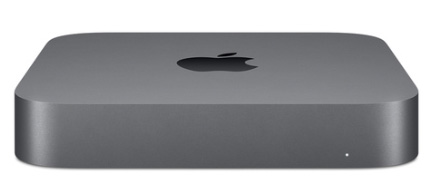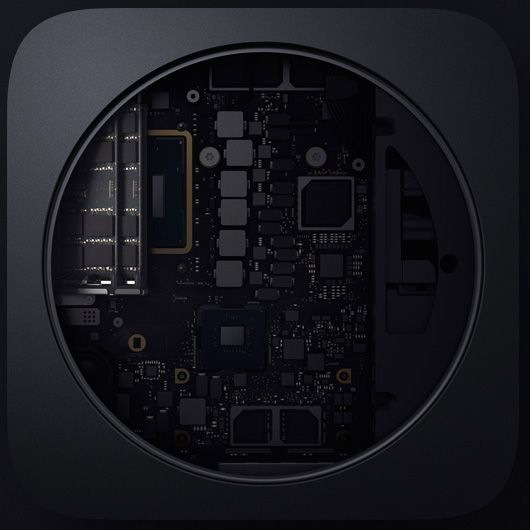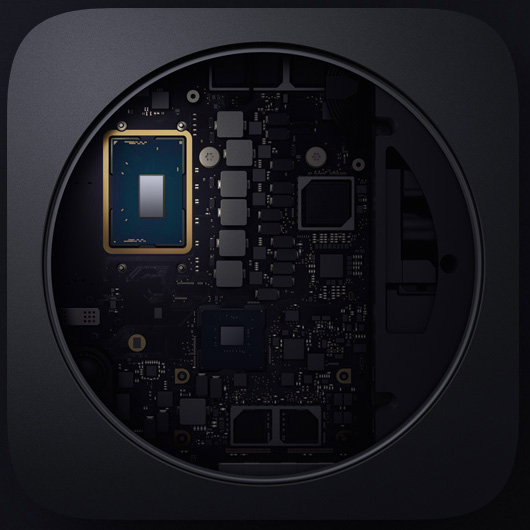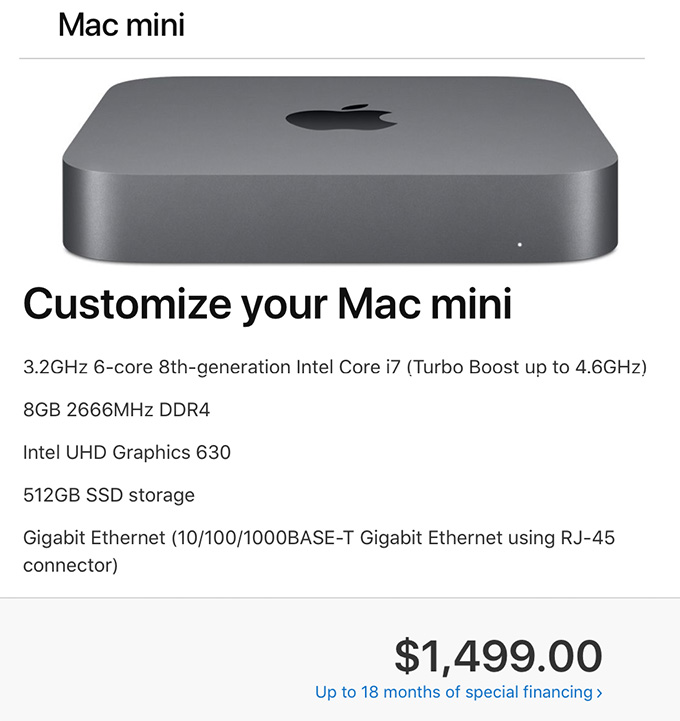 [ Updated Dec. 16, 2018, with revisions to my recommendations based on additional personal experience. ]
[ Updated Dec. 16, 2018, with revisions to my recommendations based on additional personal experience. ]
Last week, Apple announced upgrades to the venerable Mac mini. And this upgrade turned a diminutive system into a powerhouse. So much so that I’m getting a ton of email about whether we can use the Mac mini for video editing.
The short answer is: Yes.
NOTE: Here’s a hands-on article on using the Mac mini for video editing with Final Cut Pro X. This provides real-world performance data.

Like all computers, you get the best possible performance by buying a fully-tricked out, top of the line system. And, like all computers, that may require more money than you have to spend.
So the purpose of this article is to help you prioritize balancing cost vs. performance.
SYSTEM DESCRIPTION

(All images courtesy of Apple.)
Based on my research, the new Mac mini is a solid machine for video editing, with the ability to configure the system with up to 64GB of RAM, a 6-core Intel i7 desktop-class processor, and a 10Gigabit Ethernet port. The I/O available on the new Mac mini allows users to connect a number of devices through its 4 Thunderbolt 3 ports, 2 USB-A ports, HDMI 2.0 port, and analog audio output jack. With these ports, you can connect a 5K display plus a separate 4K display, or up to three 4K displays.
NOTE: The system offers Thunderbolt 3 (USB-C) ports, this means that you’ll need to purchase an adapter to connect any Thunderbolt 2 devices. These adapters are readily available from a number of vendors, including Apple, for about $50.
Links
The system also natively supports:
Two displays with 4096-by-2304 resolution at 60Hz connected via Thunderbolt 3 plus one display with 4096-by-2160 resolution at 60Hz connected via HDMI 2.0.
– OR –
One display with 5120-by-2880 resolution at 60Hz connected via Thunderbolt 3 plus one display with 4096-by-2160 resolution at 60Hz connected via HDMI 2.0
LARRY’S PRIORITIES
When it comes to optimizing a computer system for video editing, when you can’t purchase the top of the line, here are my spending priorities:
Increasingly, both Final Cut Pro X and Adobe Premiere Pro CC are leveraging the GPU for effects, rendering and export. However, the Mac mini does not give us an internal choice for GPU.
When it comes to optimizing a computer system for video compression, my priorities shift:
While some video transcoding and compressing codecs are multi-threaded (which means they take advantage of multiple cores in a CPU), many others are not. These single-threaded codecs take advantage of pure CPU speed more than the GPU.
UPDATE: I’ve been using the Mac mini outlined here for about two weeks, and running a series of media compression tests with it. Based on this, I’ve changed my recommendations for both RAM and SSD capacity.
THOUGHTS ON THE GPU
Here’s the key point behind deciding which GPU to get. A graphics processing unit is optimized for pixel manipulations: texturing, rendering, color grading, exporting… anything that involves manipulating the colors of pixels. All you are getting when you purchase a “higher-grade” GPU is more speed. Not better quality, just speed.
If you are a student, a hobbyist, or someone with indeterminate deadlines, there’s no compelling reason to get a faster GPU; the faster speed doesn’t justify the cost. If you are someone living with constant deadlines, who does a lot of effects and color grading, and needs projects exported “yesterday or sooner,” then a faster GPU makes sense.
One of the big limitations of the original Mac mini was its reliance on an Intel Iris graphics card. This was woefully underpowered for any serious graphics work, such as video editing.
That changed with the latest release. All configurations of the new Mac mini use the Intel UHD Graphics 630 card. For editors who are working primarily in HD with limited motion graphics and effects, or who have deadlines that are flexible, the Intel UHD Graphics 630 will work well.
For users who need faster performance, for example, working at higher resolutions such as 4K, with RAW video, or with more complex graphics and effects, the Blackmagic eGPU or newly announced Blackmagic eGPU Pro are great options for these types of graphics-intensive tasks. The updated eGPU Pro includes a Radeon RX Vega 56 graphics card with 8GB of high bandwidth memory. The card offers similar performance to the graphics card in iMac Pro.
Links
My recommendation is to go with the internal GPU, until you find yourself spending too much time waiting. A slower GPU does NOT mean you can’t edit, it simply means that tasks like rendering and exporting may take a little longer. If you need more speed, add an external GPU as your budget allows.

THOUGHTS ON RAM
The Mac mini ships with a minimum of 8 GB of RAM, which can be user-upgraded to 16, 32, or 64 GB. The good news here is that you can upgrade the RAM at any time, without needing to make a decision at the time of purchase.
8 GB of RAM is fine for HD editing in both Final Cut and Premiere. 4K and above frame sizes benefit from 16 GB of RAM. I have not found a compelling reason to install more than 32 GB of RAM. While the extra RAM won’t hurt, you won’t see as big a performance boost as you will by going from 8 to 32 GB of RAM. (As a note, all my iMac systems have 32 GB of RAM.)
While you can buy RAM from Apple and have it factory-installed, you can save hundreds of dollars by buying RAM from reputable third-party companies like Crucial or OWC.
UPDATE: My revised recommendation is that for a video compression system, 8 GB of RAM is fine. For video editing, more RAM is better. To keep costs low, you can purchase the minimum 8 GB configuration, then upgrade to at least 16 GB from a third-party source as you need more. If your workflow feels fast enough, you have enough RAM. If you are spending too much time waiting – add more.

THOUGHTS ON THE CPU
Apple makes it hard to compare CPUs because one is an i3, another is an i5 and the third is an i7. In looking for an understanding of the differences, I found this recent PC Magazine article:
“If you want a plain and simple answer, then generally speaking, Core i7s are better than Core i5s, which are in turn better than Core i3s. Nope, Core i7 does not have seven cores nor does Core i3 have three cores. The numbers are simply indicative of their relative processing powers.
“The more cores there are, the more tasks (known as threads) can be served at the same time. The lowest number of cores can be found in Core i3 CPUs, i.e., which have only two cores. Currently, all Core i3s are dual-core processors.” [i5 CPUs are quad core, but] “they don’t support Hyper-Threading [which is the ability of] a single core to serve multiple threads.
“This is one of the many reasons why Core i7 processors are the creme de la creme. Not only are they quad cores, they also support Hyper-Threading. Thus, a total of eight threads can run on them at the same time.
“The upshot is that if you do a lot of things at the same time on your PC, then it might be worth forking out a bit more for an i5 or i7. However, if you use your PC to check emails, do some banking, read the news, and download a bit of music, you might be equally served by the cheaper i3.”
Here’s the link to the full article: www.pcworld.idg.com.au/article/386100/what_difference_between_an_intel_core_i3_i5_i7_/
My recommendation is to upgrade to the 6-core i7. Video editing and compression, especially at larger frame sizes, requires a beefy processor. Also, it’s important to mention that these are all Intel 8th-generation 65W desktop-class processors — not mobile processors meant for notebook computers.
THOUGHTS ON STORAGE
The Mac mini comes with up to 2 TB of internal SSD which, according to reports, is blindingly fast. The problem is that in today’s media environment, 2 TB is not enough storage.
I regularly shoot projects that take multiple terabytes of storage. So, even if I invested in a 2 TB SSD, I’d still need to buy external storage. Remember, also, as your frame sizes increase or you move to HDR or high-bit-depth media, a single spinning hard drive won’t be enough. You’ll either need to purchase a RAID or another SSD.
Frankly, for a full suite of editing apps, plus the macOS, you really only need 100 GB of storage. So if you are on a tight budget, a 256 GB SSD will be enough. Personally, I like having a bit more space for exports and working files.
UPDATE My recommendation is the 512 GB SSD and reserve it for the macOS, applications and general workspace. Then, store all your and projects on externally connected media using Thunderbolt 3; preferably a RAID. After using this system for two weeks specifically for video compression, I find that the 512 SSD is the sweet spot for storage. 256 GB is acceptable, but very limiting when you need to create high-quality work files.
THOUGHTS ON INTERCONNECTION
For the first time since the iMac Pro, the new Mac mini includes the option to install 10 Gb Ethernet port. This option is especially useful for users who keep media on shared storage or for configurations that require high-bandwidth networking today or in the future.
For comparison, a 1 Gb Ethernet connection can transfer data up to 128 MB/second. A 10 Gb Ethernet connection can transfer data up to 1.25 GB/second; ten times faster. However, there are several “gotchas” here, because to take full advantage of this high-speed connection you will also need:
I fully applaud Apple for adding this connection – it is valuable and needed! However, unless the rest of your network also supports 10 Gb Ethernet – or will be upgraded to do so – adding this option won’t make any difference in your data transfer speeds.
HERE’S MY RECOMMENDED CONFIGURATION

This screen shot illustrates what I recommend. Regardless of which Mac mini you start with, you’ll end up at the same configuration for the same price: $1,499 (US). Also, remember that the Mac mini is just the computer, you’ll also need to purchase a monitor, keyboard and mouse.
UPDATE: This is the system I purchased and I’m very happy with the system. It is a workhorse for media compression – which is my principle reason for buying the unit. I only use it as a back-up system for video editing. I’m also planning on using it as a media asset management server, I’ll have more on that after the first of the year.
EXTRA CREDIT
Here are two relevant articles that may also be of interest to you:
114 Responses to Configure a Mac Mini (2018) for Video Editing
Newer Comments →-
 Loren Miller says:
Loren Miller says:
November 5, 2018 at 5:35 am
-
 Scott Newell says:
Scott Newell says:
November 5, 2018 at 5:37 am
-
 Hugh Brownstone says:
Hugh Brownstone says:
November 5, 2018 at 5:47 am
-
 Dave H says:
Dave H says:
November 5, 2018 at 6:23 am
-
 Jonathan Alexander says:
Jonathan Alexander says:
November 5, 2018 at 7:33 am
-
 Alan Halffhill says:
Alan Halffhill says:
November 5, 2018 at 8:43 am
-
 Kit Laughlin says:
Kit Laughlin says:
November 5, 2018 at 11:54 am
-
 Larry says:
Larry says:
November 5, 2018 at 9:31 pm
-
 Ismael Rosales says:
Ismael Rosales says:
November 6, 2018 at 2:04 am
-
 Larry says:
Larry says:
November 6, 2018 at 8:41 am
-
 jason says:
jason says:
November 6, 2018 at 3:07 pm
-
 Larry says:
Larry says:
November 6, 2018 at 3:41 pm
-
 jason says:
jason says:
November 7, 2018 at 4:11 pm
-
 Benoit Landot says:
Benoit Landot says:
November 7, 2018 at 2:05 am
-
 Larry says:
Larry says:
November 7, 2018 at 6:47 am
-
 Benoit LAndot says:
Benoit LAndot says:
November 7, 2018 at 7:23 am
Newer Comments →Tremendous help here, Larry. Exquisite real-world detail (especially when you get it installed). Much thanks.
Best, as always.
Loren
I swear, Larry, that you must be clairvoyant. I had all of the same questions over the weekend and you’ve answered every single one of them. Thank you again for all of the research you do and for your clear, concise writing.
Larry what a timely piece. Thanks for all you do.
Great detail and valuable info! Thanks!!
Thanks this really was useful. As always Larry I really appreciate the plain English detailed but succinct breakdown of components, and what makes sense for video editing. I was very curious when I saw these new mini’s and now I think I have a solid base to make a decision with!
When I saw the new Mini being introduced, i said to myself, this could be an editing computer. Thanks for the recommendations. I agree about the Ram since it is upgradable.
Great article, Larry, and timely as others have mentioned.
Do you have monitor recommendations?
Regards, and thanks, KL
Kit:
Thanks for the kind words. I don’t, however, have any suggestions for monitors.
Larry
The latest and greatest is fine, but I believe a savvy editor can do better in the used Mac Pro and Xserve market. I was able to pick up 3 Xserve Early 2009 2.66 GHz 8-core for render nodes and a Mac Pro 2.8 GHz 8-core Early 2008 for workstation for around $250 each. You can then get a aftermarket Nvidia or ATI graphics card, add 16 GB RAM, new SSD via PCIe expansion (OWC Accelsior or Sonnet Tempo). Out the door a 3 Xserve render node and Mac Pro with SSD cost around the same cost as a single 6-core Mac Mini with 512 GB SSD and 16 GB RAM. You have to love to tinker, but a 24-core pipeline and basic workstation is almost at the top of the line iMac Pro, and just a fraction of the price.
Ismael:
It all depends upon how much you “love to tinker.” For some, your approach is both fun and cost-saving. For others, who just need to get started now and have it work, this is too much effort.
Thanks for sharing your ideas, it is always good to have options.
Larry
Hi Larry,
Great article. Wanted to know what you think is a better deal, the MacMini at $1099 or a imac 2017 27 inch 3.4GHz quad‑core Intel Core i5, if you can catch the sale at $1500.
Also you say upgrade to the 6-core i7 on the mac mini, will this allow me to edit 4K video easily or will I still need the external GPU.
Thanks Larry
Jason:
If you don’t have a monitor, keyboard or mouse, the iMac will be better.
If you add the i7 processor to the Mac Mini and you have all the other stuff, the Mac Mini is a better choice. 4K will edit well on both systems, the only variable will be render times.
Larry
Thanks Larry, helps me make my choice
Great article. I had come to the same conclusion though I may go for an EGPU (deadlines, deadlines…). Question: would you consider stacking 2 i7 mac minis to beef up CPU processing or would there be any way to do so? I lack knowledge about “rendering farm at home”. Thanks again.
Benoit:
It doesn’t work that way. When you team multiple units together, for example, for rendering, each computer gets a small range of frames to calculate. That way, multiple sections of the same movie get rendered at once. Only Compressor supports this file “splintering.” (This is one reason DPX frames were invented, it makes render farms more efficient.)
There’s no advantage in editing to working across multiple machines, the software – FCP X or Premiere or Avid – itself doesn’t support it.
Larry
Thank you very Much Larry. I got intrigued by the Apple mac minis stacking shown in NY. You have saved me hours of research Merci!